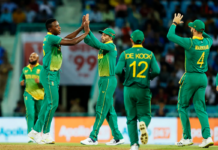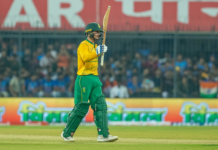“What we call the beginning is often the end.
And to make an end is to make a beginning.
The end is where we start from.”
― T.S. Eliot, “Little Gidding” (from Four Quartets)
“The work starts now. Not tomorrow. The work starts now.”
– Harmeet Singh, Team USA (After the USA’s 10 wicket loss to England in the Super 8s)
Before the start of the 2024 T20 World Cup, the USA was not even a blip on the radar of most global cricket fans.
By defeating Pakistan and Canada and holding their own against India in the group stages, they advanced to the Super 8s in their first ever World Cup. Four full test nations did not advance – Pakistan, Sri Lanka (both former champions), New Zealand and Ireland.
Team USA won the respect of the cricketing world, and their run was celebrated as an unlikely Cinderella story. Playing in the next round seemed like the icing on the cake of this accomplishment.
Not just happy to be here
But not to the players. When the Super 8s started, the US team seemed keen to compete and show they belonged among the world’s best.
As Vice-Captain Aaron Jones said before the round: “Definitely looking forward to the challenge for sure. Over the last couple of weeks, we’ve shown that obviously we could definitely compete and beat some of the full member nations.”
In its first match against South Africa, the US managed to hold its own.
South African opener Quinton de Kock scored 74 off 40 balls until Harmeet Singh finally took his wicket, after which the US were able to contain South Africa’s batsmen somewhat.
Group stage star Saurabh Netravalkar had another impressive bowling spell at 2 for 21, taking the wickets of Reeza Hendricks as well as Captain Aiden Markram.
They fell just 18 runs short in their chase of 195, and the Americans put on a respectable battle – with Andries Gous hitting 80 off 47 not out, and all-rounder Harmeet Singh hitting 38 of 22. Team USA earned even more praise from around the cricketing world.
How good have the USA been.
Commendable👌👌
Hats off #USAvSA #T20WorldCup— Ashwin 🇮🇳 (@ashwinravi99) June 19, 2024
Rude awakening
But in their final two Super 8s matches, things changed.
Against the West Indies at the Kensington Oval in Barbados, the home field advantage that had bolstered the US in its first few matches was clearly gone. The packed and partying near-capacity crowd was loud and partisan.
Also, until that match, first or second generation American immigrant players had put together an interesting streak of shining bright against their countries of origin.
Muhammad Ali Khan took the wicket of Fakhar Zaman against Pakistan. Saurabh Netravalkar famously took the wickets of Virat Kohli (golden duck) and Rohit Sharma (for 3) against India. Andries Gous, of course, had an unbeaten 80 off 47 against the Proteas.
But against the West Indies, Aaron Jones, born in Queens but raised in Barbados, could only manage 11 off 11 on what was basically his home ground – despite being one of the top few scorers of the tournament to that point. The USA were all out for 128 runs.
When the West Indies batting started, the destruction really began. They needed only 10.5 overs to chase the target of 129, and the US only took one wicket along the way.
Shai Hope completely demolished the American bowling attack with his undefeated 82 off 39 balls, including four fours and eight sixes.
The eleventh and final West Indies over was probably the most poignant. Netravalkar was hit by Shai Hope for two massive sixes, including one to end the game. He had bowled at an economy rate of under 5 in the previous three matches, and against the West Indies was at almost 11.
The Americans seemed unable to find an answer to the West Indies attack on either front, and after the loss, the US were effectively eliminated from the tournament.
More of the same
In their final match against England on Sunday, America was playing for pride. As Aaron Jones said in his pre-match press conference: “We’ll definitely go hard against England and try to finish well. Obviously, we can’t advance to the next round… Every match you play for your country is important. So, we’re definitely going to try to win the game for sure.”
The US was also hoping to play the role of spoiler, and the internet was rife with Founding Fathers memes about stopping the British.
“Listen, we may not win the World Cup but we can damn sure make England not advance” – George Washington pic.twitter.com/JGCEXfUlW2
— Major League Cricket (@MLCricket) June 22, 2024
Yet that match was very similar to the previous one, except perhaps more acute.
The USA were made to bat first again. This time, they were all out for 115 in under 19 overs. In the 19th over, England’s Chris Jordan, himself born and raised in Barbados, took four wickets in five balls, including a hat trick to end the US innings – the first one by an England bowler in a T20I.
When it was England’s turn to bat, Captain and opener Jos Buttler hit 83 not out off 38 balls, including six fours and seven sixes. Five of those sixes came in one over off Harmeet Singh. In addition to taking apart the US bowling attack (no American bowler had an economy rate below 9), Buttler actually shattered two of the stadium’s solar panels in the process:
Yep, Jos Buttler’s batting alright #USAvENG #T20WorldCup pic.twitter.com/xx67hai3J2
— England’s Barmy Army 🏴🎺 (@TheBarmyArmy) June 23, 2024
Once again, Team USA looked like a shell of its group stage self.
So what happened?
It is crucial to understanding what happened in the last two games and why. Not for the sake of being critical, but to figure out where Team USA really are in their development, to address problems and weaknesses, and to build on this success.
As Head Coach Stuart Law said after the USA’s loss to the West Indies: “I always tell the boys: if we’re not winning, we’re learning.”
Harmeet Singh echoed that after the loss to England: “When we started we were just winning. When you just win, you overlook your weaknesses. Then when when you lose you look within and then you come back stronger and become a better team.”
There are unfortunately not a lot of data points to consider. It’s important not to over-read into a few matches, but still we must look at the information we have.
Stronger competition?
One theory being floated is that the Super 8s are where the big boys of cricket come to play and get serious, the competition and level of play are tougher so the US stumble was inevitable.
Cory Anderson himself at the post-game press conference said something similar:
“What happens in these Super 8 comp[etition]s is the bigger boys start to really show up and they’re kind of hitting their stride right at the back end of this comp[etition].”
While there may be truth to this, itt does not really explain what happened to the US.
Yes, England and the West Indies are formidable teams and former champions. But so are Pakistan. True, Jos Buttler is one of the most magnificent batters the game has ever seen. But so is Virat Kohli.
The reality is that the US held its own against equally strong opposition until it didn’t.
No longer the unknown?
Another theory is that Team USA was an unknown quantity at the start of the tournament, giving them an advantage at the start of the tournament that wore off by the Super 8s.
Anderson continued: “The more we’ve played… the more footage they have on us – we were a little bit unknown coming into the comp[etition] and that’s kind of part of cricket.”
Again, this is another possible but disputable explanation. The world saw the US chase down Canada’s 194 in the opening match, and responsible planners at the PCB and BCCI would have done their research and preparation.
Just bad games?
Yet another plausible explanation is that the US is a good team that happened to have two bad games in a row, and such is cricket.
As Corey Anderson said after the England loss: “The last couple of games probably weren’t quite characteristic of us… sometimes the game gets away and days like that happen.”
Harmeet Singh agreed: “We had two bad games, which can happen to any team.”
The reality is that cricket, especially the T20 format, can be a cruel game with massive individual and team ups and downs, sometimes over multiple games. Just look at Virat Kohli through both the group and Super 8 stages at this tournament.
Even Shai Hope, the hero of the US-West Indies match, was out for a Golden Duck in the West Indies’ next contest against South Africa, which was effectively an elimination game.
Anderson, a former New Zealand International and the most experienced US player, was also self-critical of the overall tournament he had: “I needed to play better than what I did and there [were] probably opportunities that I missed out on… But again, it’s kind of how it goes, it’s just sometimes you strike while the iron’s hot when you do, and when it’s going not your way it sort of lingers around a little bit and you don’t quite get those performances that you’re after.”
Lack of experience
But beyond the mere random ups and downs of T20 cricket, there seemed to be more at play.
Playing in this tournament was uncharted territory for the USA, and toward the end it seemed harder for them to navigate, both individually and collectively.
As Stuart Law said: “The flights and the play at that intensity all the time, it takes it out of you mentally more so than physically. Some of our boys have probably worked out that going deep into a tournament like we have takes a bit more out of you.”
Anderson articulated this from another angle: “I think being the senior player in the team.. who’s played… the most international cricket here, it’s probably my role to try and get a little bit of calmness in that group and unfortunately there were times where we lost a couple of wickets quickly and you kind of need to consolidate…”
By contrast, the reflections coming out of the England locker room were different, even as they faced adversity early in the tournament and were not at their best.
As England’s Chris Jordan said, after his stellar spell: “I think the calmness within the dressing room… the dressing room has a lot of experience now, both in the playing 15 and also off the field as well. So, we’ve had some really good chats. And I think the scenarios that we found ourselves in, where we had to get our run rate up and stuff like that, and try to beat people and really dominate games, really gave us some really clear direction. I think you’re seeing that in the way we’re playing now.”
The verdict
Our sense is this: the US are a very competitive team — not at the level of the top tier of teams, but with massive potential. They also happened to perform (or overperform) extremely well early in the tournament, and possibly lost steam later on.
Some of that potential is already developed, and some of it is still raw and needs to be nurtured and worked on. And in the final two matches, what was raw became more exposed and amplified by the lack of experience. But it is now visible.
As Harmeet Singh said: “I think, losing the last two games will give us a lot of insights [into] where we really need to up our game and where we lack and where we need to really push hard and and show up better in the 2026 World Cup.”
The good news is these areas are all addressable. And to turn uneven performance into more consistent, high level performance, they absolutely must be addressed.
Where does Team USA go from here? 7 things to tackle
So what should be done now to ensure continued success?
Before answering that, it is important to distinguish between growing the sport in the US from a fan and participation perspective, and achieving sustained success for the national team at an international level. They are highly related and interdependent, but they are also distinct.
Our focus here is on the latter: how to keep Team USA winning at the highest level.
Here are some of the key items to focus on. The first four pertain to the senior team, and the last three are about developing a stronger national foundation.
1) More competition and experience through bilateral series
It is not enough for Team USA to play against Full Member countries just every other year, if at all.
Harmeet Singh calls out the need for a future where: “we’re playing a lot of games against these guys and then we get more comfortable playing against them. Not just walk up one day and then, you know, get taken apart by them.”
Anderson agrees: “any bilateral series that we get, ideally, we can get some bigger countries coming across and they’re just going to be learning experiences for guys.”
Hopefully after this performance there will be more in the offing for Team USA.
2) More T20 franchise cricket for as many players as possible, here and abroad
In their book “White Hot” about England’s relatively recent transformation into a white ball powerhouse, Matt Roller and Tim Wigmore highlighted how the ECB leadership placed emphasis on players’ taking advantage of opportunities to play franchise cricket overseas.
The exposure to other players at the highest levels, and to unfamiliar foreign playing conditions, is absolutely critical to being able to compete as a national team.
Only a handful of Team USA’s members have played in T20 tournaments abroad. More contracts should be on the way after this performance, and this should be sought out, encouraged, and facilitated.
Beyond that, the launch of Major League Cricket in the US last year was a massive leap forward in this regard. The MLC has slots for 54-60 domestic players, which will cover this full team as well as the core of the selection pool.
With the slew of marquee names that signed up for the 2024 edition, this looks to be another great season.
But again, one major domestic tournament a year provides a strong foundation, but more participation abroad where possible, even just for the top stars, will only help.
3) National team training support and facilities
Harmeet Singh said it bluntly after the loss to England: “For the whole group, we just need infrastructure to practice better, to train better. We need the whole system in place. Trainers need to be able to work with us all year even if remotely. If you see England, Australia… they have incredible infrastructure in every state. Being indoors doesn’t help. We need a lot more outdoor set-ups, we need good training facilities.”
While nationwide infrastructure at all levels is also a need (#5 below), providing it specifically for the highest levels is a more targeted and immediate step.
4) Player compensation
Much has been reported about the compensation of US players and the part-time status of many of them.
As cricket in the US grows to have more revenue sources (see #7 below), this will unquestionably need to be addressed.
Obviously this will not change dramatically overnight, but some progress needs to be made soon. And the longer-term goal should be to enable Team USA’s members to be full professionals – making their living entirely from playing cricket if they so choose.
5) Long term investment in player development at the grassroots level
Stuart Law gave his assessment of the overall US talent pool: “Even the boys back home, there’s some promising talent as well. We don’t have the depth of pool that other nations have. We will hopefully continue to grow that, gain more interest from other parts of the US. And if we can unearth a couple of more players, because we’ve got automatic qualification into the next T20 World Cup, we can pick up a few more players from local tournaments.”
The US needs to develop that pool from the top down and make it deeper. How to do so is a longer discussion that we will save for a future piece.
6) Investment in support infrastructure: facilities, umpiring, and coaching
On the facilities front, Harmeet Singh had more to say about the need at all levels, not just for the national team:
“We don’t have enough turf practice facilities everywhere. We just have kids practicing indoors… I can manage going from indoors to outdoors. I know the differences. Kids when they practice indoors, they go outdoors straight away on turf pitches, and there’s no feet, nothing. So all that needs to change and hopefully, in the near future, we’ll have a lot more practice facilities than just building grounds. Go to India or anywhere in a Test-playing nation, we have so many grounds to practice. All the academies are outdoor academies and then you go indoors [only] when it’s raining.”
And infrastructure goes beyond player development and facilities – coaching and umpiring need to be developed as well. This is no small task given America’s size and sprawl, but it has to be part of the plan.
7) Nurture fandom and the virtuous cycle
Fans mean attention which means money which means resources – and which, when deployed correctly, lead to growth and success.
So growing the sport in the US and building off the spark that was this World Cup will be imperative.
It can be all be done, with patience and commitment
None of this is rocket science, and none of these ideas are novel. It’s quite straightforward. But not easy.
As we have said before, it will take time and leadership – including well-intentioned governance, strategy and implementation – but it is possible.
American fans and Team USA don’t want to be a Cinderella, delighted to be at a royal ball courtesy of a fairy godmother.
American fans and Team USA want and ought to be a perennial cricket powerhouse, bolstered by and born of the country that is the leading global sporting economy, and one that also welcomes the best from all over the world.
It is a long journey, but the path is clear. And it starts now, at the end of this historic, unprecedented and amazing World Cup run that rocked the cricket world.

















































